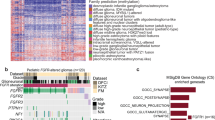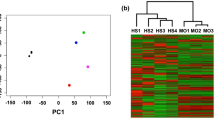Abstract
Hartsfield syndrome (HS) is an ultrarare developmental disorder mainly featuring holoprosencephaly and ectrodactyly. It is caused by heterozygous or biallelic variants in FGFR1. Recently, a dominant-negative effect was suggested for FGFR1 variants associated with HS. Here, exome sequencing analysis in a 12-year-old boy with HS disclosed a novel de novo heterozygous variant c.1934C>T in FGFR1 predicted to cause the p.(Ala645Val) amino-acid substitution. In order to evaluate whether the variant, changing a highly conserved residue of the kinase domain, affects FGFR1 function, biochemical studies were employed. We measured the FGFR1 receptor activity in FGF2-treated cell lines exogenously expressing wild-type or Ala645Val FGFR1 by monitoring the activation status of FGF2/FGFR1 downstream pathways. Our analysis highlighted that RAS/ERK1/2 signaling was significantly perturbed in cells expressing mutated FGFR1, in comparison with control cells. We also provided preliminary evidence showing a modulation of the autophagic process in cells expressing mutated FGFR1. This study expands the FGFR1 mutational spectrum associated with HS, provides functional evidence further supporting a dominant-negative effect of this category of FGFR1 variants and offers initial insights on dysregulation of autophagy in HS.
Similar content being viewed by others

Log in or create a free account to read this content
Gain free access to this article, as well as selected content from this journal and more on nature.com
or
References
Dhamija R, Babovic-Vuksanovic D. Hartsfield syndrome. In: Adam MP, Ardinger HH, Pagon RA, Wallace SE, Bean LJH, Stephens K, Amemiya A, editors. GeneReviews® [Internet]. Seattle (WA): University of Washington, Seattle; 1993–2018 (last updated: 3 Mar 2016).
Simonis N, Migeotte I, Lambert N, Perazzolo C, De Silva DC, Dimitrov B, et al. FGFR1 mutations cause Hartsfield syndrome, the unique association of holoprosencephaly and ectrodactyly. J Med Genet. 2013;50:585–92.
Hong S, Hu P, Marino J, Hufnagel SB, Hopkin RJ, Toromanović A, et al. Dominant-negative kinase domain mutations in FGFR1 can explain the clinical severity of Hartsfield syndrome. Hum Mol Genet. 2016;25:1912–22.
Ornitz DM & Itoh N. The fibroblast growth factor signaling pathway. Wiley Interdisciplinary Rev Dev Biol. 2015;4:215–66.
Teven CM, Farina EM, Rivas J, Reid RR. Fibroblast growth factor (FGF) signaling in development and skeletal diseases. Genes Dis. 2014;1:199–213.
Dode C, Levilliers J, Dupont JM, De Paepe A, Le Du N, Souss-Yanicostas N, et al. Loss- of- function mutations in FGFR1 cause autosomal dominant Kallmann syndrome. Nat Genet. 2013;33:463–5.
Villanueva C, Jacobson-Dickman E, Xu C, Manouvrier S, Dwyer AA, Sykiotis GP, et al. Congenital hypogonadism with split hand/foot malformation: a clinical entity with high frequency of FGFR1 mutations. Med Genet. 2015;17:651–9.
Tommiska J, Känsäkaski J, Christiansen P, Jørgensen N, Lawaetz JG, Juul A. Genetics of congenital hypogonadotropic hypogonadism in Denmark. Eur J Med Genet. 2014;57:345–8.
Hero M, Laitinen EM, Varimo T, Vaaralahti K, Tommiska J, Ravio T. Childhood growth of females with Kallmann syndrome and FGFR1 mutations. Clin Endocrinol (Oxf). 2015;82:122–6.
Muenke M, Schell U, Hehr A, Robin N, Losken HA, Schinzel P, et al. A common mutation in the fibroblast growth factor receptor 1 gene in Pfeiffer syndrome. Nat Genet. 1994;8:269–74.
White KE, Cabral JM, Davis SI, Fishburn T, Evans WE, Ichikawa S, et al. Mutations that cause osteoglophonic dysplasia define novel roles for fgfr1 in bone elongation. Am J Human Genet. 2005;76:361–7.
Bennett JT, Tan TY, Alcantara D, Tetrault M, Timms AE, Jensen D, et al. Mosaic activating mutations in fgfr1 cause encephalocraniocutaneous lipomatosis. Am J Human Genet. 2016;98:579–87.
Brady N, Chuntova P, Bade LK, Schwertfeger KL. The FGF/FGFR axis as a therapeutic target in breast cancer. Expert Rev Endocrinol Metab. 2013;110:e29–39.
Luo H, Zheng R, Zhao Y, Wu J, Li J, Jiang F, et al. A dominant negative FGFR1 mutation identified in a Kallmann syndrome patient. Gene. 2017;621:1–4.
Lopez ME & Korc M. A novel type I fibroblast growth factor receptor activates mitogenic signaling in the absence of detectable tyrosine phosphorylation of FRS2. J Biol Chem. 2000;275:15933–9.
Rozen S & Skaletsky H. Primer3 on the WWW for general users and for biologist programmers. Methods Mol Biol. 2000;132:365–86.
Micale L, Loviglio MN, Manzoni M, Fusco C, Augello B, Migliavacca E, et al. A fish-specific transposable element shapes the repertoire of p53 target genes in zebrafish. PLoS ONE. 2012;7:e46642.
Yuan H, Li ZM, Shao J, Ji WX, Xia W, Lu S. FGF2/FGFR1 regulates autophagy in FGFR1-amplified non-small cell lung cancer cells. J Exp Clin Cancer Res. 2017;36:72.
Weekes D, Kashima TG, Zandueta C, Perurena N, Thomas DP, Sunters A, et al. Regulation of osteosarcoma cell lung metastasis by the c-Fos/AP-1 target FGFR1. Oncogene. 2016;35:2852–61.
Dhamija R, Kirmani S, Wang X, Ferber MJ, Wieben ED, Lazaridis KN, et al. Novel de novo heterozygous FGFR1 mutation in two siblings with Hartsfield syndrome: a case of gonadal mosaicism. Am J Human Genet. 2014;164A:2356–9.
Prasad R, Brewer C, Burren CP. Hartsfield syndrome associated with a novel heterozygous missense mutation in FGFR1 and incorporating tumoral calcinosis. Am J Human Genet. 2016;170:2222–5.
Shi Y, Dhamija R, Wren C, Wang X, Babovic-Vuksanovic D, Spector E. Detection of gonadal mosaicism in Hartsfield syndrome by next generation sequencing. Am J Human Genet. 2016;170:3359.
Takagi M, Miyoshi T, Nagashima Y, Shibata N, Yagi H, Fukuzawa R, et al. Novel heterozygous mutation in the extracellular domain of FGFR1 associated with Hartsfield syndrome. Hum Genome Var. 2016;3:16034.
Lansdon LA, Bernabe HV, Nidey N, Standley J, Schnieders MJ, Murray JC. The use of variant maps to explore domain-specific mutations of FGFR1. J Dent Res. 2017;96:1339–45.
Oliver JD, Menapace DC, Cofer SA. Otorhinolaryngologic manifestations of Hartsfield syndrome: case series and review of literature. Int J Pediatr Otorhinolaryngol. 2017;98:4–8.
Mizushima N, Yoshimori T, Ohsumi Y. The role of Atg proteins in autophagosome formation. Annu Rev Cell Dev Biol. 2011;27:107–32.
Choi AM, Ryter SW, Levine B. Autophagy in human health and disease. N Engl J Med. 2013;368:651–62.
Cinque L, Forrester A, Bartolomeo R, Svelto M, Venditti R, Montefusco S, et al. FGF signalling regulates bone growth through autophagy. Nature. 2015;528:272–5.
Wang Z, Huang J, Zhou S, Luo F, Tan Q, Sun X, et al. Loss of Fgfr1 in chondrocytes inhibits osteoarthritis by promoting autophagic activity in temporomandibular joint. J Biol Chem. 2018;293:8761–74.
Zhang J, Liu J, Huang Y, Chang JY, Liu L, McKeehan WL, et al. FRS2alpha-mediated FGF signals suppress premature differentiation of cardiac stem cells through regulating autophagy activity. Circ Res. 2012;110:e29–e39.
Acknowledgements
We thank the patient and his family for participation in this study. We acknowledge Professor Soo-Hyun Kim (University of London, UK) for providing myc-FGFR1 wild-type vector, and G. Zampi (IBBR, Naples, Italy) and M.P. Leone (Fondazione IRCCS-Casa Sollievo della Sofferenza, San Giovanni Rotondo, Italy) for technical assistance. This work was supported by Ricerca Corrente 2018 granted by the Italian Ministry of Health to LM, Ricerca Finalizzata 2011 granted by the Italian Ministry of Health to LM (GR2011–02349694) and M Carella (RF2011–02350693). The funders had no role in study design, data collection and analysis, decision to publish, or preparation of the manuscript.
Author contributions
PP, LM, and M Castori designed the study and wrote the manuscript. PP, M Carella, and TB performed exome sequencing and bioinformatic analysis. LM and GN carried out the functional assays. LM, RM, M Castori, and EDS interpreted functional data. M Castori, AP, and MCS provided clinical evaluation of the patient. All authors contributed to the writing and reviewing and approved the main manuscript text.
Author information
Authors and Affiliations
Corresponding author
Ethics declarations
Conflict of interest
The authors declare that they have no conflict of interest.
Additional information
Publisher’s note: Springer Nature remains neutral with regard to jurisdictional claims in published maps and institutional affiliations.
Rights and permissions
About this article
Cite this article
Palumbo, P., Petracca, A., Maggi, R. et al. A novel dominant-negative FGFR1 variant causes Hartsfield syndrome by deregulating RAS/ERK1/2 pathway. Eur J Hum Genet 27, 1113–1120 (2019). https://doi.org/10.1038/s41431-019-0350-4
Received:
Revised:
Accepted:
Published:
Issue date:
DOI: https://doi.org/10.1038/s41431-019-0350-4
This article is cited by
-
Biological pathways leading to septo-optic dysplasia: a review
Orphanet Journal of Rare Diseases (2025)


